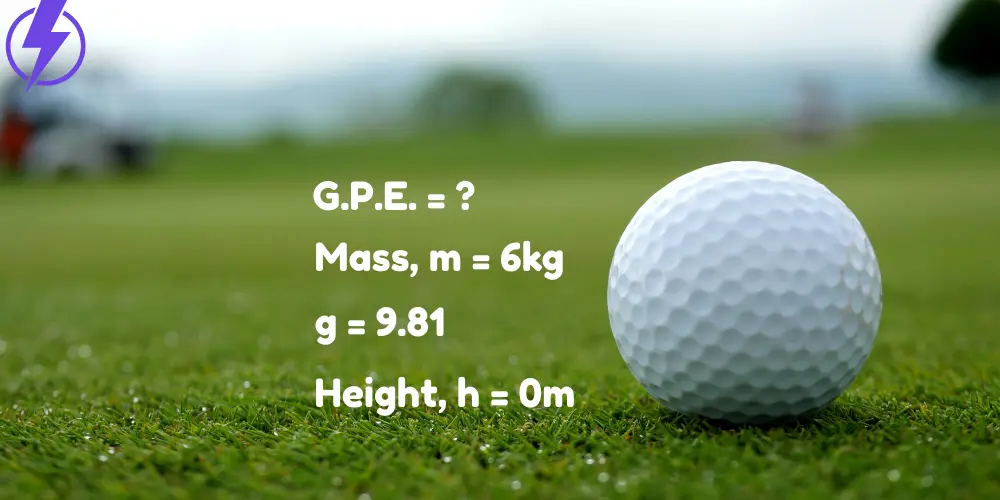Gravitational potential energy (GPE) is the energy stored in an object due to its height above a reference point. However, if an object is lying directly on the ground (height = 0 m), its gravitational potential energy is zero because it has no potential to fall.
Statement
Calculate the gravitational potential energy stored in a 6 kg ball lying on the ground (h = 0 m).
Use g = 9.81 N/kg.
Data (Given Values)
From the question, the given values are:
- Mass of the object (m) = 6 kg
- Height above ground (h) = 0 m
- Acceleration due to gravity (g) = 9.81 N/kg

Required (To Find)
We need to calculate the gravitational potential energy (PE) of the object.
Formula to Use
The standard formula for gravitational potential energy (GPE) is:
PE = mghwhere:
- PE = Potential Energy (Joules, J)
- m = Mass (kg)
- g = Acceleration due to gravity (9.81 m/s²)
- h = Height (m)
Solution:
We are given:
- Mass (m) = 6 kg
- Height (h) = 0 m
- Acceleration due to gravity (g) = 9.81 N/kg
Step 1: Write the formula
PE = mgh
Step 2: Substitute the given values
PE = 6 × 9.81 × 0
Step 3: Perform the calculations
PE = 6 × 0
PE = 0 J
Final Answer: The gravitational potential energy stored in the ball is 0 Joules (J).
Result
Thus, the gravitational potential energy stored in a 6 kg ball lying on the ground (height = 0 m) is:
PE = 0 JExplanation
Why is the Potential Energy Zero?
Gravitational potential energy depends on height (h). If an object is on the ground, its height is 0 meters. Since the formula for potential energy (PE = mgh) includes h as a factor, any value multiplied by 0 results in zero.
This means that objects at ground level have no gravitational potential energy because they cannot fall further.
Step-by-Step Breakdown
- Identifying the Given Values
- Mass = 6 kg, Height = 0 m, and g = 9.81 N/kg.
- Substituting Values into the Formula
- We used the standard potential energy equation: htmlCopy code
PE = mgh - Then substituted the values: htmlCopy code
PE = 6 × 9.81 × 0
- We used the standard potential energy equation: htmlCopy code
- Performing the Calculation
- 9.81 × 0 = 0
- 6 × 0 = 0 J
- Final Answer
- The final answer is 0 Joules (J), which confirms that objects lying on the ground have no gravitational potential energy.
Real-Life Applications of Gravitational Potential Energy
Although an object on the ground has zero potential energy, if we lift it above the ground, it gains potential energy. Some real-world applications include:
- Hydropower Plants: Water stored at high elevations has potential energy that converts into kinetic energy when it falls.
- Sports Physics: In basketball, a ball gains potential energy when lifted and loses it when it hits the ground.
- Roller Coasters: At the highest points, roller coasters have maximum stored energy before moving downward.
Final Thoughts
This numerical problem confirms that gravitational potential energy is zero when an object is at ground level. The PE = mgh formula is a fundamental concept in physics that applies to real-world scenarios like hydropower plants, sports, and amusement park rides.
If you want to calculate gravitational potential energy instantly, try our Potential Energy Calculator for fast and accurate results.

